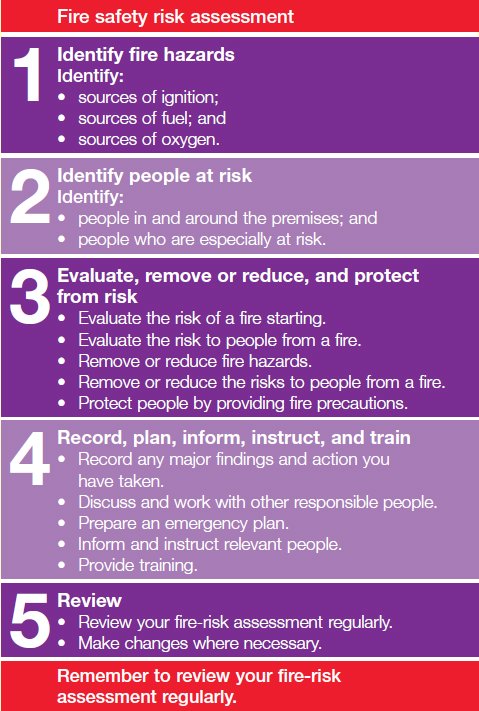Fire risk assessment
Building Safety Act 2022: Section 156
Written fire risk assessment and fire safety arrangements.
The previous requirement to have a written fire risk assessment only applied in certain circumstances (e.g. where the responsible person employees five or more persons). This will no longer be the case, and if you are a responsible person, then you will need to record both your fire risk assessment and fire safety arrangement in full, regardless of the size or purpose of the business or premises.
For more information please visit our section 156 page.
Fire safety in your business premises
Under current Fire Safety Legislation, you, as a Responsible Person within your business, must carry out a suitable and sufficient Fire Risk Assessment. This assesses the risk of fire to your employees and others who are associated with your business and its work. If you feel that your premises is too complex to write one yourself, you can use the Fire Sector Federation guide (.pdf) to help you choose one.
Nottinghamshire Fire and Rescue Service categorises premises by risk level, placing premises that have sleeping on site or visitors that may be unfamiliar with the layout in a higher risk category due to delays in discovery of fire or making an escape.
The Department of Communities and Local Government (DCLG) issues Guidance Documents to help recognise the fire risks for particular premises, dividing them into size and nature of premise eg. Healthcare, Factories and Warehouses, and Offices and Shops. These guidelines are designed to help the responsible person comply with the requirements of the Regulatory Reform (Fire Safety) Order.
In order to measure the risk of your premises, you may also need to calculate your maximum occupancy levels. This is worked out using the number and width of the fire exits available per person. You can download a simple guide to calculating occupancy figures.
A guide to making your small non-domestic premises safe from fire is another useful tool for writing your own risk assessment. This should help you methodically follow the five key steps of Fire Risk Assessments.
Fire safety risk assessment

- Identify fire hazards
- Sources of ignition
- Sources of fuel
- Sources of oxygen
- Identify people at risk
- People in and around the premises
- People who are especially at risk
- Evaluate, remove or reduce and protect from risk
- Evaluate the risk of a fire starting
- Evaluate the risk to people from a fire
- Remove or reduce fire hazards
- Remove or reduce the risk to people from a fire
- Protect people by providing fire precautions
- Record, plan, inform, instruct, and train
- Record any major findings and action you have taken
- Discuss and work with other responsible people
- Prepare an emergency plan
- Inform and instruct relevant people
- Provide training
- Review
- Review your fire-risk assessment regularly
- Make changes where necessary
Templates
Our Fire Risk Assessment templates are for guidance and should help you methodically follow the five key steps of Fire Risk Assessments. These should be used in conjunction with the DCLG Guide which is relevant to the size of your premises and the nature of your business.
We have several templates to help you:
- Fire risk assessment template (.docx, 14 pages, 41Kb)
- worked example of a completed fire risk assessment (.pdf, 30 pages, 670Kb)
- Fire safety logbook (.docx, 31 pages, 155Kb) to help with the maintenance of your fire safety provision, such as fire alarm testing records
If you plan to hold a temporary event, you can apply for a Temporary Event Notice online.